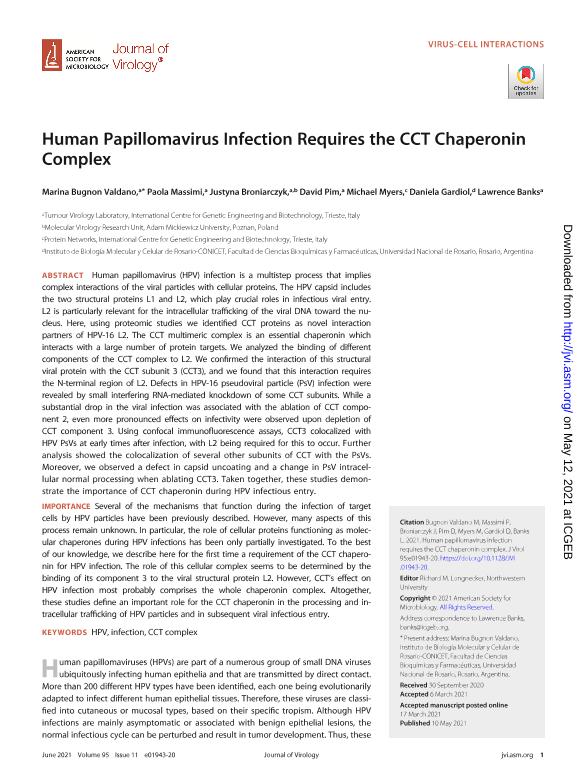Mostrar el registro sencillo del ítem
dc.contributor.author
Bugnon Valdano, Marina Paula

dc.contributor.author
Massimi, Paola
dc.contributor.author
Broniarczyk, Justyna
dc.contributor.author
Pim, David
dc.contributor.author
Myers, Michael
dc.contributor.author
Gardiol, Daniela Nora

dc.contributor.author
Banks, Lawrence
dc.date.available
2023-01-26T11:27:06Z
dc.date.issued
2021-06
dc.identifier.citation
Bugnon Valdano, Marina Paula; Massimi, Paola; Broniarczyk, Justyna; Pim, David; Myers, Michael; et al.; Human papillomavirus infection requires the CCT chaperonin complex; American Society for Microbiology; Journal of Virology; 95; 11; 6-2021; 1-20
dc.identifier.issn
0022-538X
dc.identifier.uri
http://hdl.handle.net/11336/185671
dc.description.abstract
Human papillomavirus (HPV) infection is a multistep process that implies complex interactions of the viral particles with cellular proteins. The HPV capsid includes the two structural proteins L1 and L2, which play crucial roles in infectious viral entry. L2 is particularly relevant for the intracellular trafficking of the viral DNA toward the nucleus. Here, using proteomic studies we identified CCT proteins as novel interaction partners of HPV-16 L2. The CCT multimeric complex is an essential chaperonin which interacts with a large number of protein targets. We analyzed the binding of different components of the CCT complex to L2. We confirmed the interaction of this structural viral protein with the CCT subunit 3 (CCT3), and we found that this interaction requires the N-terminal region of L2. Defects in HPV-16 pseudoviral particle (PsV) infection were revealed by small interfering RNA-mediated knockdown of some CCT subunits. While a substantial drop in the viral infection was associated with the ablation of CCT component 2, even more pronounced effects on infectivity were observed upon depletion of CCT component 3. Using confocal immunofluorescence assays, CCT3 colocalized with HPV PsVs at early times after infection, with L2 being required for this to occur. Further analysis showed the colocalization of several other subunits of CCT with the PsVs. Moreover, we observed a defect in capsid uncoating and a change in PsV intracellular normal processing when ablating CCT3. Taken together, these studies demonstrate the importance of CCT chaperonin during HPV infectious entry. IMPORTANCE Several of the mechanisms that function during the infection of target cells by HPV particles have been previously described. However, many aspects of this process remain unknown. In particular, the role of cellular proteins functioning as molecular chaperones during HPV infections has been only partially investigated. To the best of our knowledge, we describe here for the first time a requirement of the CCT chaperonin for HPV infection. The role of this cellular complex seems to be determined by the binding of its component 3 to the viral structural protein L2. However, CCT’s effect on HPV infection most probably comprises the whole chaperonin complex. Altogether, these studies define an important role for the CCT chaperonin in the processing and intracellular trafficking of HPV particles and in subsequent viral infectious entry.
dc.format
application/pdf
dc.language.iso
eng
dc.publisher
American Society for Microbiology

dc.rights
info:eu-repo/semantics/openAccess
dc.rights.uri
https://creativecommons.org/licenses/by-nc-sa/2.5/ar/
dc.subject
CCT COMPLEX
dc.subject
HPV
dc.subject
INFECTION
dc.subject.classification
Virología

dc.subject.classification
Ciencias Biológicas

dc.subject.classification
CIENCIAS NATURALES Y EXACTAS

dc.title
Human papillomavirus infection requires the CCT chaperonin complex
dc.type
info:eu-repo/semantics/article
dc.type
info:ar-repo/semantics/artículo
dc.type
info:eu-repo/semantics/publishedVersion
dc.date.updated
2022-09-19T16:01:46Z
dc.journal.volume
95
dc.journal.number
11
dc.journal.pagination
1-20
dc.journal.pais
Estados Unidos

dc.description.fil
Fil: Bugnon Valdano, Marina Paula. Instituto Cent.for Genetic Engineering ; Italia. International Centre for Genetic Engineering and Biotechnology; Italia. Consejo Nacional de Investigaciones Científicas y Técnicas; Argentina
dc.description.fil
Fil: Massimi, Paola. International Centre for Genetic Engineering and Biotechnology; Italia. Instituto Cent.for Genetic Engineering ; Italia
dc.description.fil
Fil: Broniarczyk, Justyna. International Centre for Genetic Engineering and Biotechnology; Italia. Instituto Cent.for Genetic Engineering ; Italia
dc.description.fil
Fil: Pim, David. International Centre for Genetic Engineering and Biotechnology; Italia. Instituto Cent.for Genetic Engineering ; Italia
dc.description.fil
Fil: Myers, Michael. Instituto Cent.for Genetic Engineering ; Italia. International Centre for Genetic Engineering and Biotechnology; Italia
dc.description.fil
Fil: Gardiol, Daniela Nora. Consejo Nacional de Investigaciones Científicas y Técnicas. Centro Científico Tecnológico Conicet - Rosario. Instituto de Biología Molecular y Celular de Rosario. Universidad Nacional de Rosario. Facultad de Ciencias Bioquímicas y Farmacéuticas. Instituto de Biología Molecular y Celular de Rosario; Argentina
dc.description.fil
Fil: Banks, Lawrence. International Centre for Genetic Engineering and Biotechnology; Italia. Instituto Cent.for Genetic Engineering ; Italia
dc.journal.title
Journal of Virology

dc.relation.alternativeid
info:eu-repo/semantics/altIdentifier/doi/http://dx.doi.org/10.1128/JVI.01943-20
Archivos asociados
